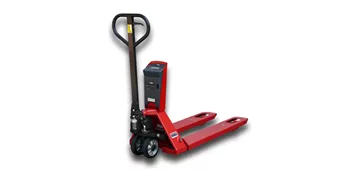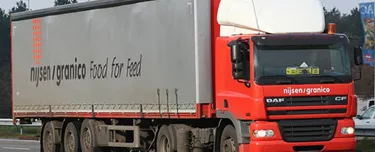"If I pick up at your place and the pallet truck says 400 kilo, you expect an invoice based on 400 kilo. There is no reason for discussions afterwards."
- P. SMETS, PLANNER/PURCHASER RAW MATERIAL
Weight picked up determines invoice
Nijsen Granico collects waste products from producers in the food industry, like bakeries. The weight picked up determines the invoice Nijsen Granico makes to the customer. Therefore the weighing procedure is a matter of trust. Nijsen Granico uses nine lorries to weigh 600 to 700 containers at approx. 60 customers each day.
Substantial waiting periods at the weigh bridge
The problem with weighing afterwards:
Nijssen Granico used to pick up the containers with waste products during the day. The drivers worked according to a schedule of maximum five customers per day. The number of containers picked up was registered.
In the evening, the bridge at the factory was used to weigh the containers. This was done as follows:
- Drive the lorry on the weigh bridge, get out of the lorry and register total weight (the weigh bridge weighs in graduation steps of 20 kg)
- Remove the lorry from the weigh bridge
- Unload the containers picked up at the last customer
- Drive the lorry on the weigh bridge, get out of the lorry and register weight difference
- Remove the lorry from the weigh bridge
- Unload the containers from the next customer
- Drive the lorry on the weigh bridge, get out of the lorry and register weight difference
- These steps have to be repeated until all containers are unloaded and weighed
This took at least two hours. Nijsen Granico only has one weigh bridge and thus it is often occupied. This results in substantial waiting periods. P. Smets: 'We used to have night shifts. The lorries were collecting until five in the afternoon and only after that the trucks could be weighed. The trucks had to go around and the neighbours were inconvenienced by this.'

Solution: weighing at the customer's premises
The former procedure has been changed completely: the weighing is done at the customer’s premises. During transport the RAVAS weighing hand pallet truck is stored in a small compartment underneath the lorry, so no loading space is lost. The drivers are working according to a schedule of maximum 15 customers each day. Smets: 'Now we are more flexible and we make less mistakes: everything is handled by one person. For me it means one man less on year basis, and of course no more weighing at the customer’s premises: confirm the customer’s confidence.'

COMPANY
Nijsen Granico Food Recycling
LOCATION
Veul, The Netherlands
APPLICATION
Controlling waste flows
Controlling waste flows
Every production process generates rest materials and waste. These waste materials are either recycled into the production process or removed and destroyed. These procedures are often expensive, making reduction of waste flows an important issue. Monitoring waste flows, i.e. knowing how much waste is produced at each spot in the production line, is the first step towards controlling and minimizing waste flows. With a mobile scale on the pallet truck or forklift truck that removes the waste material, you can efficiently measure waste production anywhere in production, finding out which processes should be optimized.
